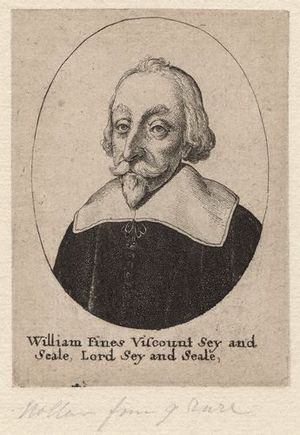William Fiennes, 1st Viscount Saye and Sele facts for kids
Quick facts for kids
The Viscount Saye and Sele
|
|
|---|---|

Engraving of Lord Saye by Wenceslas Hollar, mid-seventeenth century.
|
|
| Born | 28 June 1582 Broughton, Oxfordshire, England
|
| Died | 14 April 1662 (aged 79) Broughton, Oxfordshire, England
|
| Burial place | Broughton, Oxfordshire |
| Spouse(s) | Elizabeth Temple of Stowe |
| Children | James Fiennes, 2nd Viscount Saye and Sele Nathaniel Fiennes John Fiennes Bridget Clinton, Countess of Lincoln |
| Parent(s) | Richard Fiennes, 7th Baron Saye and Sele, Constance Kingsmill |
William Fiennes, 1st Viscount Saye and Sele (born 1582, died 1662) was an important English nobleman and politician. He was known for speaking out against King Charles I during the 1620s and 1630s. He also helped set up several colonies in other countries.
Contents
Early Life and Family Background
William Fiennes was born on June 28, 1582, at Broughton Castle in Oxfordshire, England. This castle was his family's home. He was the only son of Richard Fiennes, who was the 7th Baron Saye and Sele, and his mother Constance.
He went to New College, Oxford for his education. William Fiennes was related to William of Wykeham, who founded the college. In 1613, William took over his father's title as Baron Saye and Sele.
Standing Up to the King in the 1620s
During the later years of King James I's rule, William Fiennes became a strong opponent of the royal court. He believed the king and his advisors had too much power.
In 1621, he spoke out against Francis Bacon, a powerful figure, and wanted him removed from his noble title. In 1622, he disagreed with a special tax the king tried to collect. He said that only Parliament had the right to ask people for money. Because of this, he was put in prison for six months.
Later, he briefly worked with George Villiers, 1st Duke of Buckingham, to oppose Spain. Because of this, he was given the higher title of Viscount Saye and Sele in 1624.
Challenging Charles I
When Charles I became king, William Fiennes continued to oppose the crown. In 1626, he defended the rights of noblemen against the new king. He also spoke up for others who were accused by the king's supporters.
In 1628, he used the right of noblemen to formally disagree with decisions in Parliament. He strongly opposed the king's attempts to change the Petition of Right, a document that protected the rights of English people.
Adventures in Colonization
During a time when King Charles I ruled without Parliament, William Fiennes spent his time and money on setting up colonies overseas. He had both financial and religious reasons for doing this.
Providence Island Colony
In 1630, he joined with other important Puritan leaders like Robert Greville, 2nd Baron Brooke and John Pym. They started a company to create a colony on Isla de Providencia, an island in the Caribbean Sea. This island is now part of Colombia.
New England Settlements
William Fiennes also got land in New England on the Connecticut River in 1632. He worked with Lord Brooke and others on this project. They sent John Winthrop the Younger to be the governor and built a fort called "Sayebrook" at the river's mouth.
They also bought land in New Hampshire in 1633. William Fiennes and Lord Brooke even thought about moving to New England themselves. However, they wanted to create a system where only noble families could be governors. This idea was not popular with the colonists.
Eventually, William Fiennes gave up his plans for New England. The settlements in New Hampshire were given to Massachusetts in 1641. Sayebrook was sold to Connecticut three years later.
Old Saybrook, Connecticut is named after William Fiennes and Lord Brooke.
Political Actions in the 1630s
Many leading Puritans, including John Pym, met with William Fiennes at Broughton Castle. They planned how to oppose King Charles I. William Fiennes was very clever at following legal rules to outsmart the king's advisors. This earned him the nickname "old subtlety."
He refused to pay a tax called ship money, which the king tried to collect without Parliament's approval. Even so, he went with King Charles I on a trip against the Scots in 1639. However, he was one of only two noblemen who refused to swear an oath to fight for the king with all his power.
King Charles I tried to win him over by making him a Privy Councillor and Master of the Court of Wards.
English Civil War and Beyond
When the English Civil War began, William Fiennes sided with Parliament. He was part of the committee of safety and became the Lord Lieutenant for several counties. He even raised a group of soldiers who took control of Oxford.
He helped pass an important law called the self-denying ordinance. In 1647, he supported the army in its disagreements with Parliament.
After King Charles I was executed, William Fiennes stepped away from public life. He became a privy counsellor again when Charles II became king. William Fiennes died at Broughton Castle on April 14, 1662.
Family Life
William Fiennes married Elizabeth Temple in 1600. She was about 15 years old at the time.
Their oldest son, James, became the 2nd viscount after his father. Other sons, Nathaniel and John Fiennes, were also involved in Parliament. His daughter Bridget married a distant cousin, Theophilus Clinton. Another daughter, Ann, married Sir Charles Wolseley.
The title of Viscount Saye and Sele ended in 1781. However, the barony (a lower noble title) continued through the descendants of his son's daughter.
Images for kids


